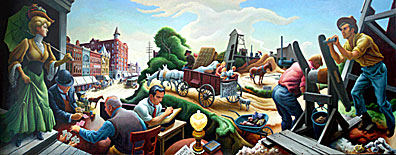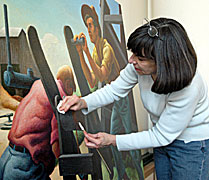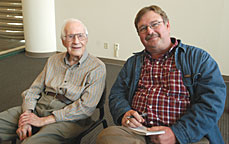
What an awesome feeling to be able to stand close to the mural of Joplin at the Turn of the Century conceived and painted by artist Thomas Hart Benton 33 years ago for Joplin's 100th birthday. A sense of history seemed to be escaping from the 5 1/2 foot high by 14 foot wide mounted canvas that was a reminder of the City in the days of covered wagons, mining, busy downtown streets, and, of course, the infamous House of Lords with its ladies of the evening and popular poker tables.

Joan Gorman, Senior Paintings Conservator for the non-profit Upper Midwest Conservation Association of Minneapolis, MN, can be seen busy at work restoring the mural which was last cleaned in the 1990s. Using a kelating agent, Gorman was reviving the vibrant acrylic colors used by Benton that are characteristic of mural painting.
"I found black specks on the painting," Gorman said, referring to splatters of paint that occurred when lighting fixtures were re-painted at its old location. "But that happens even in places where people should know better," she added.
Photos by Vince Rosati

Nonagenarian Henry Warden converses with Joplin Globe's Wally Kennedy. Both are sitting opposite the mural painted by Thomas Hart Benton aptly named "Joplin at the Turn of the Century." Warden explained how he and his late wife Mary Curtis had to convince the aging artist's wife that her husband needed to paint just one more mural for posterity. The mural currently worth about $8 million was purchased by the City of Joplin for $60,000 with the help of a $10,000 grant from the National Endowment for the Arts. The mural, that attracts many tourists, is in its new location near the new offices of the Joplin Visitors and Convention Center.
Yesterday Wally Kennedy, a city news reporter for The Joplin Globe, chatted with Henry Warden while Gorman worked. Kennedy had invited the 94-year-old Warden to view the mural with him and reminisce about its origins. Henry and his late wife Mary Curtis were instrumental in convincing their friend Benton to create the masterpiece. Correspondence between Mary Curtis and Benton, a part of the artifacts outlining the mural's creation that eventually will be part of an exhibit in the Newman Building, show how painstaking Benton's efforts were in keeping with historical accuracy. The letters suggest how an interchange of photographs and drawings helped Benton re-create the mural's individual themes.
(See "Benton Mural Moved to New Home" by Wally Kennedy, March 8, 2005, Joplin Globe.)
The mural will be the largest piece of art to be displayed. Professional art mover, Pic Art of St. Louis re-located the mural from the Joplin government building on Third St. to the new City Hall in the Newman Building at 602 Main St. where it will hang above the main elevators.
When questioned what effect the sprinkler system located in the ceiling to the right of the unenclosed mural might have on it, Gorman replied, "Of course, there would be water damage. But that's better than the possibility of the mural burning up."






Comments